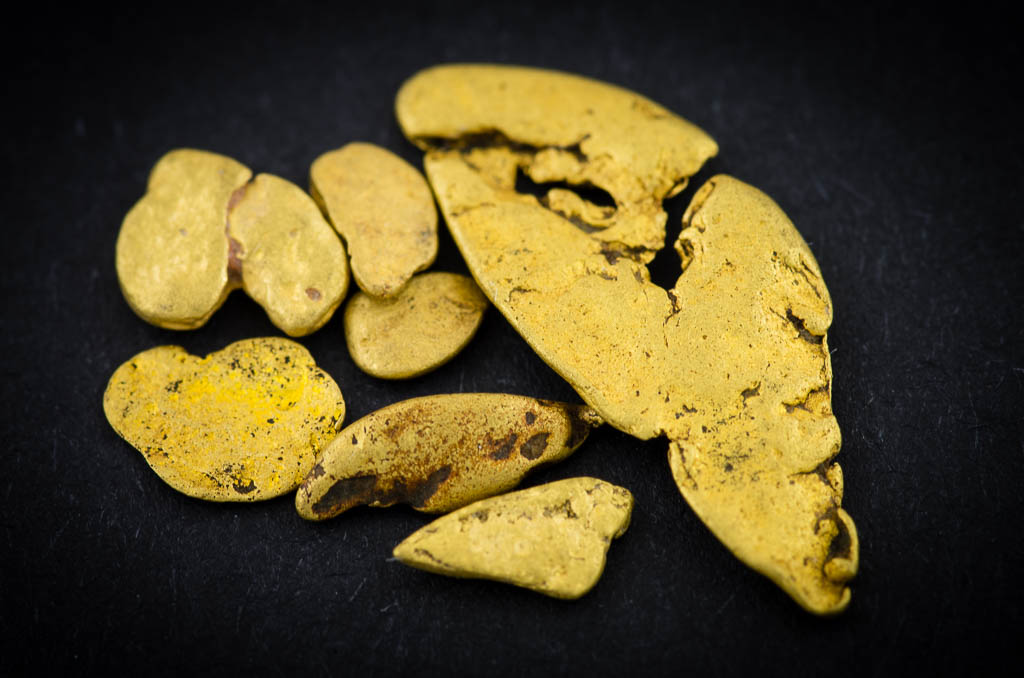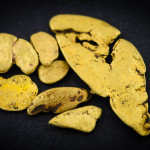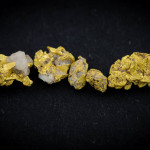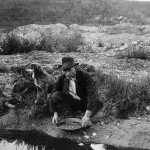Are you interested in looking for alluvial gold? Did you know that most Tasmanian gold rushes and all but one of Tasmania’s great gold mines were found by prospectors originally following leads of alluvial gold? In this post I will briefly describe alluvial gold, and go into places you might go, where to do research, and link to some good videos on gold panning, useful if you’re just starting out.
What is alluvial gold?
Alluvial gold is gold that has been freed from its host rock and ended up where it is after having been moved by water. Examples would include modern river and creek gravels, fossil tertiary river beds and terraces, as well as modern and ancient beach deposits. If you’ve ever panned for gold, you’ve almost certainly panned alluvial gold. Unlike angular, crystalline reef gold that has recently been freed from its parent rock and hasn’t travelled far, alluvial gold is usually waterworn and rounded, or flattened after being pounded by other river rocks during its journey. Here are the two kinds for comparison:
- Alluvial gold
- Reef gold
Where can you find some?
I’m looking at eventually covering most of the well-known alluvial gold areas in separate posts, so I won’t go too much into detail of places to go at this stage. Unlike gemstones (sapphires, chalcedony) and mineral specimens, there is no designated fossicking area for gold in Tasmania. This means that you need a prospecting licence, and have to fit around exploration licence holders, who may refuse you permission to prospect in their tenement. Areas where I’ve done OK, but permission is required (good luck!) include Mangana, Lefroy, Branxholm and Lisle. Out of these I’d recommend Lisle/Golconda as the easiest to access, and I provided some info in my post on northeast goldfields on current tenements around Lisle. Please keep in mind that this is written in mid-2015, and mining tenements come and go over time. You can check out current ones on MRTmap by overlaying the tenement layers over the map layers. I’ve put together a video that shows how to do this. On the topic of there not being a fossicking area set aside for gold, I would encourage you to write to the Director of Mines and ask for one. His address is:
Director of Mines, PO Box 56, Rosny Park 7018, Tasmania
The more who write the merrier, if they don’t hear that people want one, they’ll never get around to designating one. In the meanwhile you can get by with a prospecting licence, but it will cost you nearly $30, and lasts only 12 months. Other people have reported success finding small gold around the Hadspen boat ramp in summer, when the water is low, and Doctors Rocks seems to still be producing gold from fine to occasionally small nuggets, and is the closest to a designated Fossicking Area that we have.
More information
There is a very comprehensive list of locations where alluvial gold has been found in Tasmania in Ralph Bottrill’s booklet ‘Alluvial Gold in Tasmania’, which is a free download (PDF) from the MRT library. However, the grid coordinates provided in this book are a mix of AGD66 and GDA94 datums, and there is no indication of which is which, so they’re difficult to map. Your best bet for location info is the MRTmap overlay for mineral occurrences, which also tells you the accuracy of the coordinates. The MRT library, in general, is a useful place to find old reports, maps, and modern exploration company reports. I wrote a section on my post on northeast gold on how to use Google to search their online resources.
There are many places on the Internet to find information on alluvial prospecting. The Tas-Prospecting forum has a dedicated section on alluvial mining, mostly in the Tasmanian context. There are many other online forums that have sections or information on alluvial gold. I regularly browse two that are based in Australia: Prospecting Australia and the Gold Detecting and Prospecting Forum.
Dave McCraken has a good article on the New 49ers about placer geology and the classic places to search for gold in a stream, which I already linked to in my post on Weld River sapphires.
It’s worth keeping in mind that, if you’re going to a known goldfield, the old timers did a pretty good job of getting the easily accessible gold. Especially if it was found on classic placer locations as described in McCraken’s article. This leaves us mostly looking for stuff that they either missed, or was too far to bether with, or not good enough to be worthwhile for any reason. Bedrock Dreams blog has a good series of posts on “High Point Gold“, or gold that is transported only in the very largest floods, and ends up well above normal river level, which is worth a read. It’s my experience that slate rock bars well above the river can carry gold in places like Mathinna and Mangana, and a lot of this article makes good sense, and will help to widen your search.
Tools: The Pan
The traditional tools of the gold prospector are the pan, or dish, the cradle, and the sluice. The gold pan is the only piece of equipment that is absolutely, unambiguously legal to use in Tasmania to separate gold from dirt. Here I’ll cover a bit about gold pans and how to use them, and in another post I’ll go into cradles and sluices, which can process material more quickly, and metal detectors. To this day in Tasmania, the legality of using some of these three for gold prospecting is a grey area.
Gold pans have been around as a way to separate gold from lighter sand and gravel for a very long time. They have been the standard equipment for mobile prospectors since the 1840s-1850s gold rushes, as they are small, portable and versatile. There is an interesting article (PDF) on the history and variety of gold pans in the World Placer Journal. The modern gold pan is made of either steel or plastic, but plastic is becoming more and more common. There are more designs than you can poke a stick at, but they all do essentially the same thing, and you can safely ignore the claims that some designs are far better than others. My own preference is for black or green, 15-inch diameter plastic pans, but it’s all about what you’re used to. Riffles help when you’re starting out, and they make you more confident that you won’t loose the gold, but once you get used to gold panning you won’t need them, and many people find it easier to pan off the last bit of material in the side without riffles.
Learning gold panning
There are hundreds or perhaps thousands of videos on YouTube showing how to pan gold. Many or most are pretty useless, or trying to sell you something, which I find annoying.
Of the selection of videos on gold panning around at the moment, I’ve found the following three to be the most useful to me:
- How to pan for gold with Rob Towner. Short and sweet showing just the up/down panning motion.
- How to pan for gold, showing the side-to-side style of panning:
- Gold panning – backwash & tap method, the most useful, and a real eye-opener when I first discovered it. The best way to separate gold from concentrate:
If you’re interested in alluvial gold methods that are more productive than panning, have a read of Alluvial Gold part 2, where I go into higher production methods like sluicing, cradling and highbanking.
Happy prospecting!
Do you like the content at Apple Isle Prospector? Feel free to get in contact, or leave a comment.





Great info and article!
Thanks!
Good info. Great you took time to type up
I run fisher gb pro..hit a o.1 target last weekend loving the depth in tas. Found few normal targets etc. (state forest)
Nice gear worked well in nz
To hopful prospects in tas
Thanks mate,
I’ve never used the GB pro. My previous experience with VLF detectors is that they don’t work in our better goldfields, but do ok on mullock. I’ve found most of my gold in ground where the VLF chatters and squeaks non-stop, and even some PI detectors struggle with false positives on ironstone rocks. The tiny coil would struggle to cover much ground when nugget-hunting other than mullock, wouldn’t it?
interesting would like to try my father in law did some panning at drs rocks many years ago would like some info please
Hi Wally,
There is gold in Doctors Rocks among the gravel close to bedrock. Once upon a time it was easier to find above high-tide, but nowadays it’s best to wait for a fairly low tide and dig among rock pools. Gold sinks to the bottom because it’s so heavy, so look for places to dig where you can get right down. I hear Seabrook Creek also has some, but I don’t know any more than that.